The History of the WSOP Main Event
Learn about the history of the WSOP Main Event and the many WSOP Champions who have won the biggest prize in poker.
Where Champions Are Made
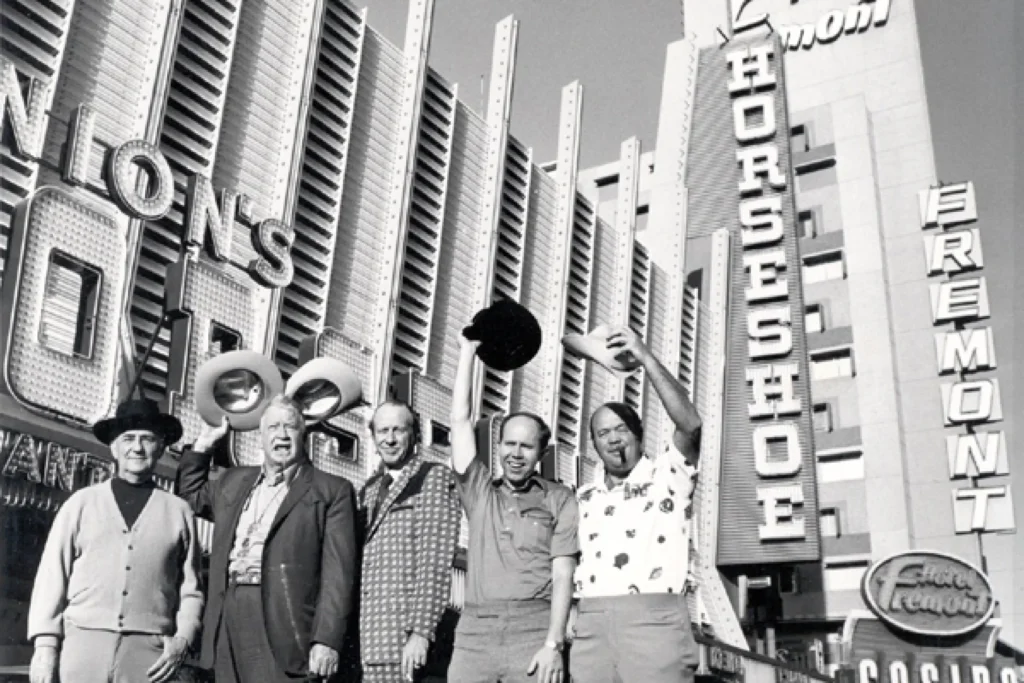
When any poker player is asked to name the tournament they most want to win, they will give a clear and certain answer: the World Series of Poker (WSOP) Main Event.
It doesn’t matter whether they’re a professional of many years standing, or an amateur just learning the game.
They might be from the United States or Australia, Europe or Antarctica. And even if they have won it already, they’ll say they want to win it again.
The WSOP Main Event stands alone as the most prestigious event in poker. Its winner gets to call themselves world champion, and in the modern era the pay-out will be in the high seven figures, sometimes even more.
The title comes with a glittering bracelet whose jewels will shimmer beneath the flashes of a thousand cameras, and the winner becomes an icon for poker the world over.
The annual event is still played in a room surrounded by the images of its former champions, many of whom are considered some of the best poker players in the world, plastered across huge banners hanging from the walls.
But what makes the World Series so special? How did an ambitious publicity stunt grow into something so significant? What makes the WSOP Main Event unique?
To begin to answer these questions, we need to go back to the early days where we find a brash and confident marketeer, well known for employing whatever tactics he needed to get whatever he wanted.
But even he could have had no idea how successful this poker idea would become.
“Anything Goes“
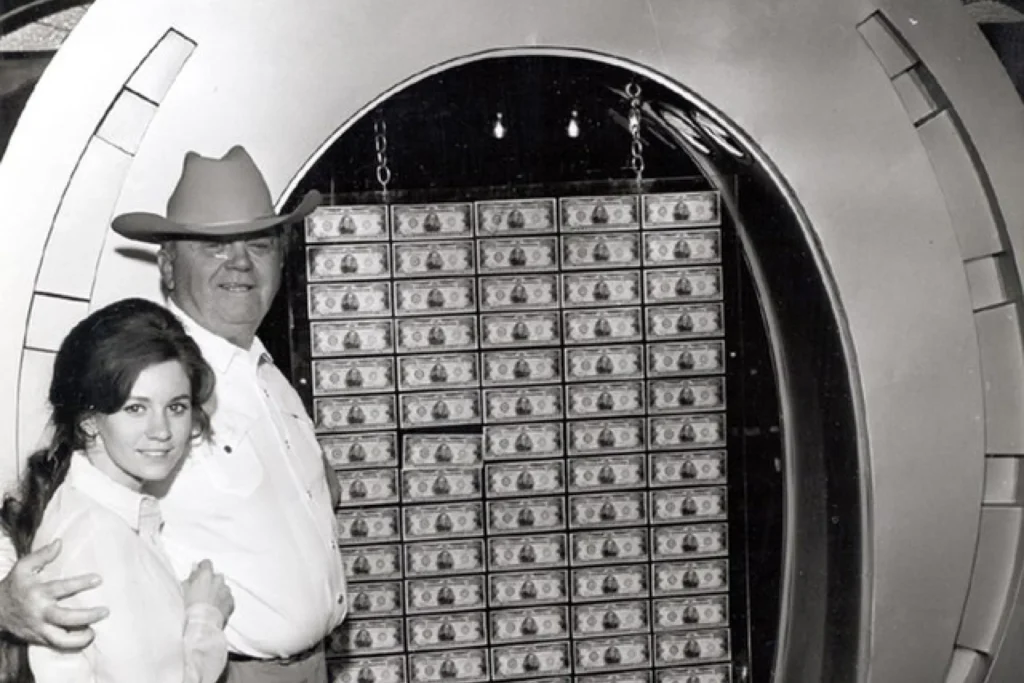
The name of the man with a plan was Benny Binion, a prominent gangster-turned-casino boss, who in 1970 owned the Horseshoe Casino, on Fremont Street, in downtown Las Vegas. Binion was looking for new ways to get people through his casino door, to lure them back to what was then known as Glitter Gulch, away from the rapidly developing Las Vegas Strip.
The year previously, Binion had attended an event in Reno known as the Texas Gamblers Reunion, where a handful of high-stakes poker players played a rotation of games for a few days, before handing out trophies to one another.
The Reno casino owner wasn’t enthusiastic to host again – the poker players didn’t lose enough money to the house to make it worth his while – but Binion sensed an opportunity. He appropriated the event, gave it a snappier title, and handed out invitations to around 30 or 40 players that read:
Mr Benny Binion cordially invites you to join him in the anything goes World Series of Poker, April 13 thru 17, 1970. Complimentary room, food and beverage will be provided by Binion’s Horseshoe Hotel & Casino, Las Vegas.
Memories are slightly uncertain about that very first World Series of Poker. It’s not known precisely how many people played, nor how many more were lured to the Horseshoe to watch. It’s also not clear how long the series lasted, nor how much money was wagered, though these will have been the biggest poker games being played anywhere at the time.
Most witnesses agree that there were five poker variants – five-card draw, deuce-to-seven draw, seven-card stud, razz and no limit Texas Hold’em – and that the line-up of players featured all the most revered poker rounders of the day: Doyle Brunson, Thomas ‘Amarillo Slim’ Preston, Jack ‘Treetop’ Straus, Brian ‘Sailor’ Roberts, Walter ‘Puggy’ Pearson and Alvin ‘Titanic’ Thompson, among others.
There was also the most celebrated player of the era: the tough Texan, Johnny Moss. At the end of the long sessions of cash games, players were asked to vote on who they thought was the best player – or, more accurately, who they thought was the ‘second-best’ player, after everyone initially voted for themselves. Moss was the man they chose, despite his notoriously abrasive, unforgiving manner. “A lot of gamblers hate me, but they still vote on me being the best player in the world,” Moss said years later.
For all the skills of the players, the first World Series was not much to look at. “You need to give it some structure, create some drama, and make it a real tournament,” a bored Los Angeles Times reporter named Ted Thackrey Jr. told Binion, according an account in the 2009 book Cowboys Full, by James McManus.
With encouragement from some of the players, Binion took Thackrey’s advice and the 1971 World Series Main Event became a Texas Hold’em freezeout tournament, with a $5,000 entry fee. Six players stumped up the cash, and Moss was the last man standing, claiming the full $30,000 prize.
The WSOP Main Event was born.
From Small Seeds
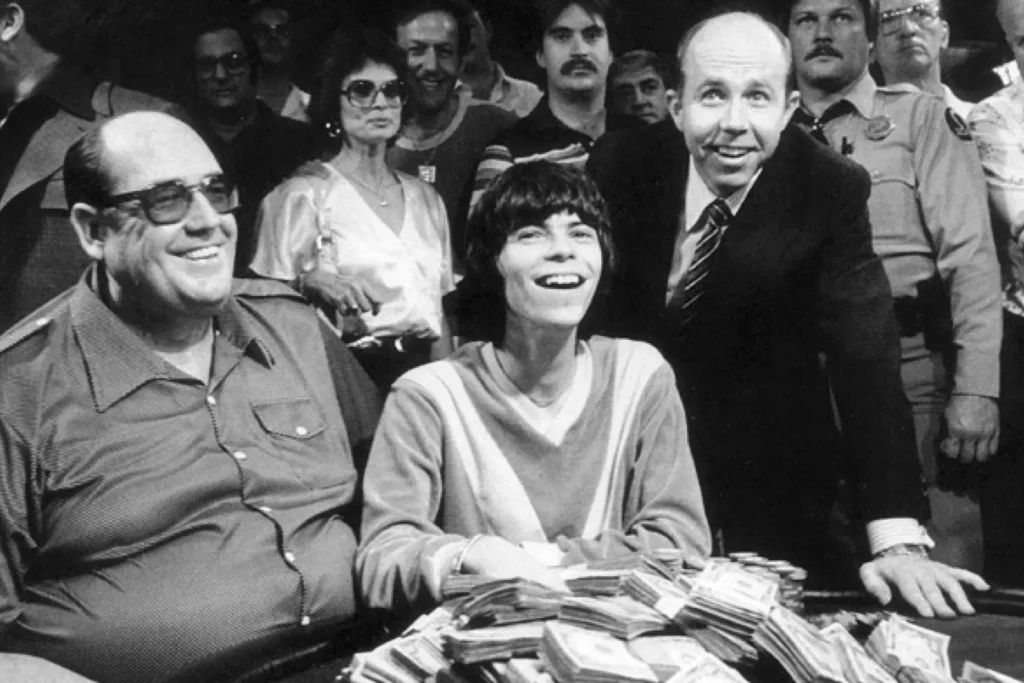
Everything immediately started to grow. The buy-in doubled the following year, and eight players got involved. Preston, who had been one of the most vocal advocates for the shift in format and increased buy-in, took down the $80,000 prize.
Over the next five years, with the $10,000 buy-in now established, the old guard continued to dominate, even as the fields swelled. Pearson, twice a runner-up, won in 1973; Moss won again in 1974; and Brunson went back-to-back in 1976 and 77, beating fields of 22 and 34. It was still winner-takes-all, and Brunson earned $220,000 and then $340,000. His final hand on both occasions was ten-deuce, which twice became a full house. The World Series was already the kind of place where mystical things were happening.
Poker was also gradually gaining a foothold in the mainstream. After his 1972 victory, Preston became a one-man publicity machine for the game, embarking on a tour of the late-night talk-shows, spinning extravagant yarns and playing up to stereotypes of incorrigible scoundrels wagering eye-watering sums.
The American network CBS filmed a documentary about the World Series in 1973, then Brunson’s famous victories spawned a best-selling book. Binion had previously said he dreamt of the event attracting 50 players. It quickly went beyond.
Bobby Baldwin, Stu Ungar and the Young Guns
All the publicity attracted new players, many of them several years younger than the established set.
Bobby Baldwin
The first poker whippersnapper to win the WSOP Main Event was 28-year-old Bobby Baldwin, an Oklahoma State University dropout who nevertheless schooled the old timers with a studious, analytical approach to poker.
With an appearance perhaps better suited to a computer lab than a gambling hall, Baldwin’s poker acumen was without question and he was by far the youngest WSOP champion when he won in 1978. However, Baldwin’s mark stood for only two years before the arrival of player blessed with even more blazing brilliance.
Stu Ungar
Stu Ungar was born in a rough neighbourhood of New York’s Lower East Side, the son of a bar owner, loan shark and bookmaker, and was immediately immersed in the world of hustling and gambling. He became an ace gin rummy player while he was still a child and dropped out of high school, supporting his widowed and incapacitated mother through his gambling profits.
Ungar adapted his formidable card skills for the more profitable world of poker and was immediately unbeatable. He won the Main Event in 1980, aged 27, and later claimed it was the first Texas Hold’em tournament he had ever played.
But it was no fluke: Ungar defended his title a year later, displaying flawless instincts and a level of raw talent that has maybe never been matched.
Ungar’s personal life was calamitous, undermined by devastating drug addiction and an inability to manage his money, emotions or talent. Everyone who knew or observed ‘The Kid’ feared that his path of self-destruction would ultimately lead to only one place.
But before the inevitable occurred, Ungar somehow hauled himself back to the WSOP in 1997, a physical wreck, and won the tournament for a third time – the only player ever to do so. His poker skills were undiminished, but his $1 million prize money vanished almost immediately. Less than 18 months later, Ungar was dead.
The Professional Era
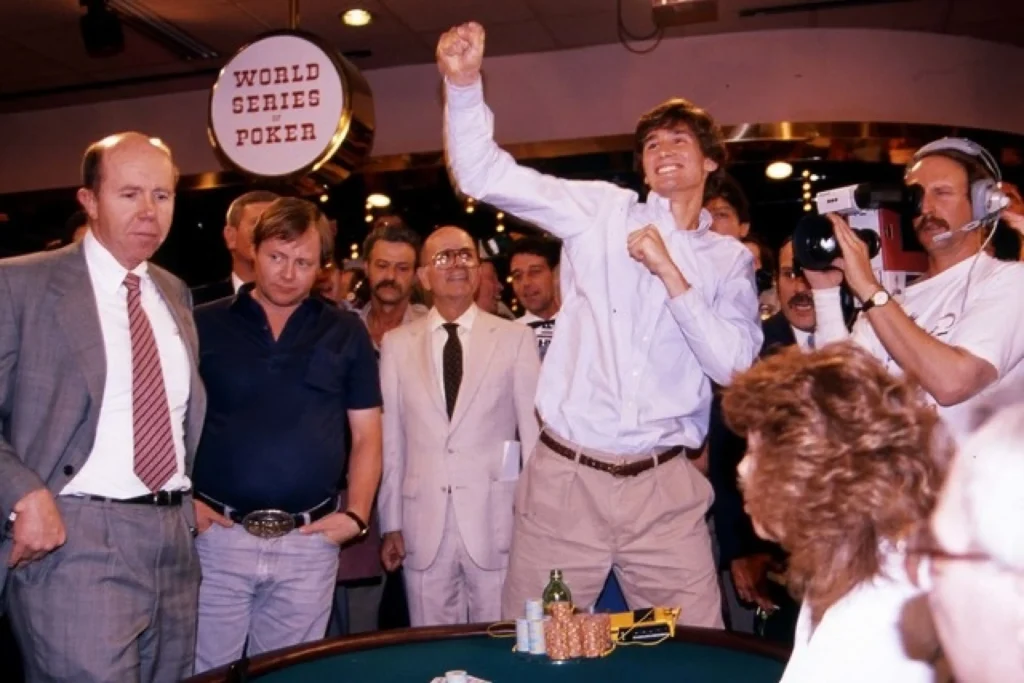
Stu Ungar was a notable maverick in a world that grew ever more professional in line with its increase in popularity. The first field of more than 100 assembled in 1982, and it passed 200 in 1991, at which point the first prize hit $1 million for the first time. The China-born Johnny Chan became another sensation of the era, winning back-to-back titles in 1987 and 88, and denied an unprecedented third on the spin by the emergence of another incredible young talent, Phil Hellmuth.
Chan and Hellmuth were the final two players from a field of 178 in 1989, but it was 24-year-old Hellmuth from Madison, Wisconsin, another college dropout, who prevailed and assumed the mantle of youngest-ever champion.
Hellmuth went on to win more than a dozen bracelets (and counting), taking advantage of an ever-expanding schedule of events under the World Series branding. The Main Event remained the Main Event, but the World Series festival grew into days and weeks and months, encompassing dozens of tournaments at all levels. Eventually, the World Series of Poker also expanded overseas.
The Moneymaker Effect
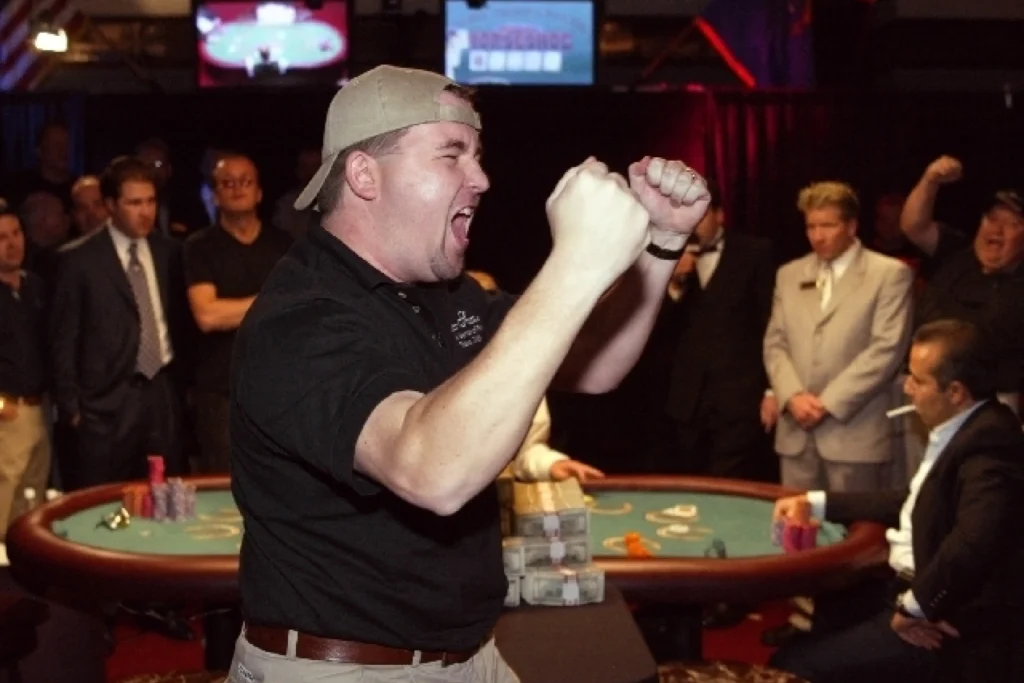
Poker became a fixture on TV while the online game was also beginning to develop. Attendance figures at the WSOP Main Event grew rapidly through the 1990s and early 2000s, before the stars aligned to sensational effect in 2003, igniting poker’s seismic boom.
The story has been told many times over, but it never fails to impress: a 27-year-old accountant from Tennessee won the WSOP Main Event at his first attempt, banking $2.5 million. But that was only a fraction of the story. This player had won his buy-in in an online satellite, booking his place in the tournament for a total outlay of only $80.
He beat some of the best in the world, riding his luck when he needed to, but never losing his focus nor his everyman charm, which brought the TV cameras regularly to his orbit. There was also the small matter of his Hollywood-perfect name. He was called Chris Moneymaker, and he could do no wrong.
With the whole world enamoured by the success of Moneymaker, and the knowledge that if he could do it, then so could anyone, poker went berserk. The online cardrooms signed up new players in their millions, while the World Series braced for an invasion.
There were 839 players when Moneymaker won in 2003; there were 2,576 a year later when another online qualifier, Greg Raymer, took the title. It then hit 5,619 in 2005 and an incredible 8,773 in 2006. The winner that year, a trash-talking Californian named Jamie Gold, picked up $12 million, the biggest prize the tournament has awarded.
Although online poker shrank in the wake of legal changes to the world of online poker, and the World Series numbers reduced in response, there have still never been fewer than 6,000 players at the Main Event (the year of the pandemic excluded).
Players have continued to get younger – Joe Cada won the title in 2008, aged 21 – and come from further and further afield. There have been Main Event champions from Argentina, Australia, Germany, Ireland, Denmark, Canada, Sweden and Ecuador, among others, as well as the United States.
So Much Has Changed, So Much Has Stayed The Same
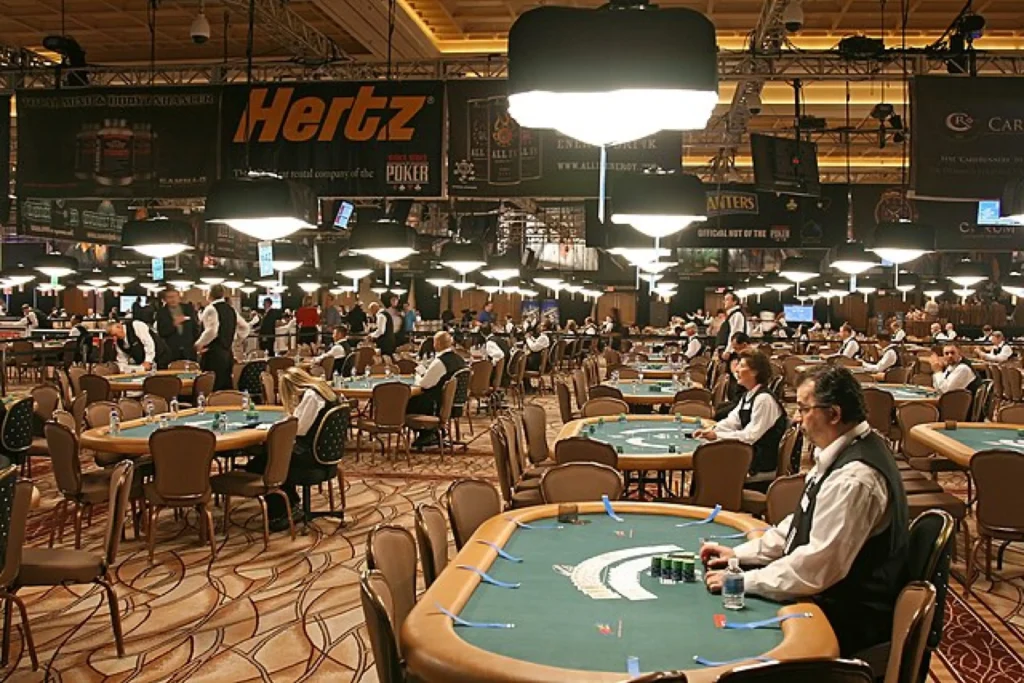
Benny Binion died in 1989 and would probably struggle to recognise the WSOP in its contemporary form. It is now populated by thousands of players of all ages from across the world – more than 110 nations were represented in 2021 – and the tournament screens on television and the internet to a global audience of millions. Binion would no doubt approve of the footfall, but it’s a far cry from the handful of white, middle-aged Texans who first sat down one week to play a bunch of cash games in a tiny cardroom.
Although the event remained at the Horseshoe until 2004, the post-Moneymaker boom demanded bigger premises, and the venue switched to the cavernous conference facilities of the Rio from 2005 through 2021. For many of these years – between 2006 and 2016 – organisers also separated the Main Event finale from the rest of the tournament series and made a separate spectacle of the multi-million-dollar climax.
During these years, the Main Event played down to its final nine players during its summer stretch, before the tournament paused until late autumn. The so-called November Nine then returned to play it out on the stage of the enormous Penn & Teller Theater in front of a raucous crowd. Again, Binion would have loved it.
Despite all these changes, and good degree of tinkering with the tournament structure, the buy-in for the Main Event remains $10,000. And crucially the tournament is also still a freezeout, meaning that all players, no matter their bankroll, have only one shot per year at the big one. Bad beat, cooler, poor play or bad luck, it doesn’t matter: when it’s over, it’s over, and the long countdown to next year begins.
The Main Event itself remains the ultimate attraction. In 2022, it relocated to the Strip for the first time, in the Bally’s and Paris hotels, promising an even larger capacity. And so it remains the centerpiece of the annual poker calendar, with pros and amateurs, celebrities and home-game heroes doing battle for millions.
The WSOP Main Event may be more than 50 years old already, but there’s no reason to think it can’t make 100, and many years beyond.